How to Choose Technology Stack for Web Application Development: Tips To Follow
Updated 04 Jul 2023
17 Min
16134 Views
It is difficult to underestimate the impact of a properly chosen web tech stack on the project's general success. The technology stack that powers your product does not only bring it to life but stand for its further maintainability, scalability, and many other factors. However, a lot of things should be taken into account before getting a perfect web tech stack and other web development services.
Here at Cleveroad, we deal with a technology stack selection for our projects regularly. In this article, we are going to share some thoughts and our experience with you concerning on how to choose a web tech stack and what frontend and backend tech stacks include.
What Is a Web Technology Stack?
First of all, it is worth considering some basic notions. What are web development stacks? It is a combination of tools such as programming languages, frameworks and so one, that were used while building a mobile or web solution. In turn, these tools are divided into the frontend and backend. Let's observe the fundamental description of the operation principle of those two integral parts:
Each web app consists of layers that are built atop the one below, forming a stack. Because of this, the components of the stack are extremely interdependent. You can create your web application from a variety of tools, frameworks, and programming languages.
Every web solution comprises the layers that are architected above and beneath, laying down a stack in combination. Due to this fact, all the elements are interrelated.
Due to the great diversity of technologies available nowadays, the selection of the relevant tech stack may be challenging. We'll also cover the factors that determine the toolset later in this article.
Frontend technology stack
The frontend is a visual part of your product. In other words, everything your customers can see and interact with while using your solution is built with the help of different sets of frontend stack.
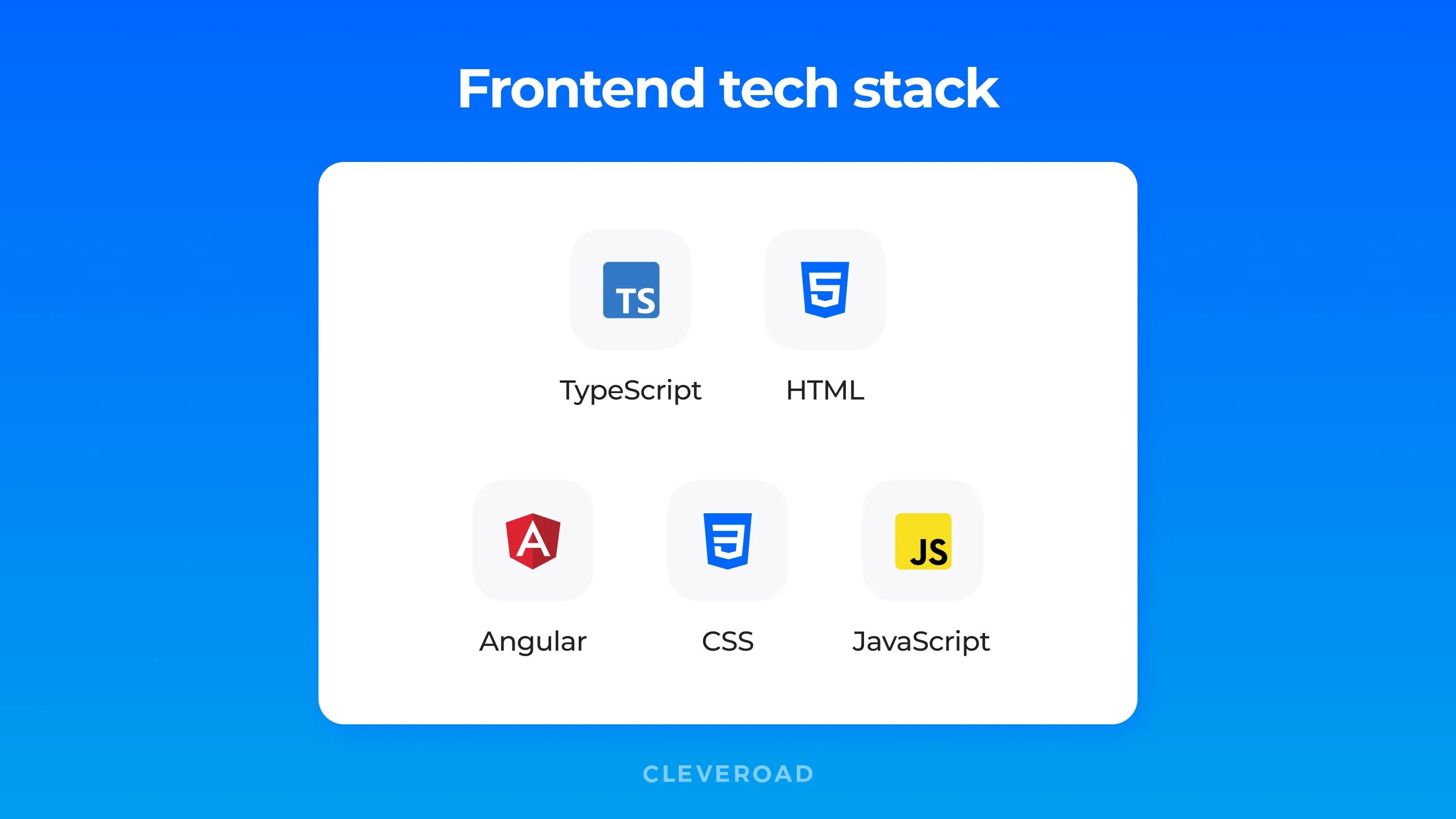
Tech stack for frontend
Talking about web dev stacks, there are some basic technologies having a variety of frameworks that under certain circumstances make the coding process faster, easier, and more flexible.
The core web technologies list includes:
- HTML
- CSS
- JavaScript
- SCSS
- SASS
- LESS
In addition, these technologies have dozens of frameworks. Thus, one of the most popular CSS-based frameworks is Bootstrap.
Also, JS language includes such frontend frameworks and libraries like Angular, React, Vue, jQuery and many more. Our developers pay attention to these frameworks as they have all the necessary features to build frontend of web apps.
See what web trends are popular right now. Read 8 web development trends every CTO should be ready for in 2024
Also, for frontend building the following languages are used:
TypeScript. A language based on JavaScript. It simplifies and accelerates the development process. One of the most popular frontend frameworks Angular is built using TypeScript. By the way, almost each our web project at Cleveroad was built using Angular and TypeScript. By the way, you can find out how to hire Angular developer for your project. Here are a few examples of them:
- AYIO (P2P marketplace for finding specialists);
- Openmind (mentoring platform);
- TrainAway (platform to find gyms around the world);
- LetsSurf(a service to find a partner for surfing)
CoffeeScript. A language that is translated into JavaScript. it makes it possible to write more compact code.
Frontend UI frameworks include solutions like React, Vue, and Angular. Such tech tools enable you to create within the current structures and elements. Besides, many successful modern projects are architected with a Flutter platform, which is excellent for architecting web applications, such as PWAs or SPAs, and turning your already built mobile product into a web solution.
Frontend web development includes tools for assembly. Our frontend developers prefer using JS tools for WebPack, Gulp, and Grunt. They help automate routine processes like compression and concatenation of images, JS files, and tables.
In fact, JavaScript language is the main technology of our web developers (both frontend and backend) since this language has all necessary frameworks, libraries and other auxiliary tools to build full-fledged large websites. And it is included in almost each modern web development stack.
Backend technology stack
The backend technology stack for web applications is always behind the scene since users cannot interact with them directly. They serve for business logic creation. To clear it up, when you are filling in a form to enter some service and press a button - you interact with the frontend stack technologies, while backend gives you access to further use by checking if the information you entered is valid.
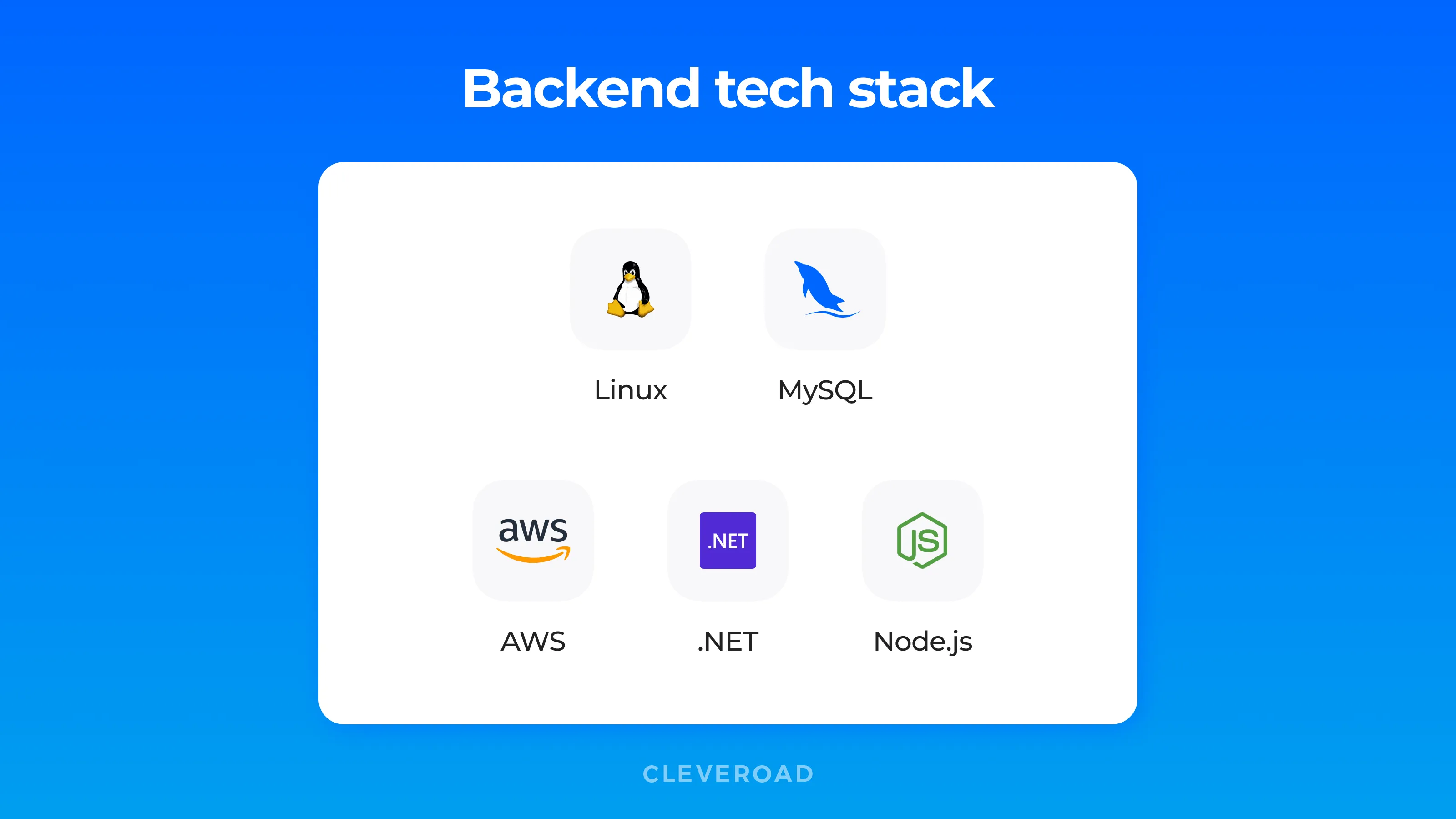
Tech stack for backend
Backend includes a server, an application, and a database. Server-side is the main side where developers build business logic, work with hostings, deploy their web app, work with databases as well. A web application is a term which includes operating system, web server, language, frameworks.
Let’s describe the whole backend tech stack which includes the following elements with names of technologies:
Operating system
This is the first stage of backend development - choose OS where developers will build a web app. Linux and Windows are the two main operating systems we work with.
Web server
The server is required to process HTTP requests sent from the browser and then return HTTP responses in the form of web pages. nginx and Apache are examples of the most popular servers.
Databases
An organized structure designed for storage and processing of large amount of interrelated information like figures, dates, geopositions. MySQL, PostgreSQL, MongoDB, ElasticSearch, DynamoDB, Firebase Database, Indexed DB 2.0 are databases our web developers prefer using.
Get acquainted with a guide to hire JS developers in 2019. Read How to hire JavaScript developers
Storage
Services for objects storage where all large files like images are stored. AWS S3 and Firebase Storage are storages used more frequently due to their reliability and convenience.
Hosting
A service that makes it possible for website owners post their website onto the Internet. Our developers use Firebase Hosting, AWS S3 Bucket in hosting mode, Amazon EC2 (Linux), nginx as the most reliable hosting services.
Programming language
A language which is used to write code for backend. There are many existing languages like PHP, Ruby, Java, C#, Python. Our developers focus on two following languages - JavaScript (Node.js platform) and C# (.Net). As for JS, many popular web development stacks include this language.
Web development frameworks
Frameworks are tools that enhance web apps and simplify the process of code writing. As programming languages, there are many backend frameworks like Laravel, Yii2, Zend, but our backend devs prefer using Express, Nest.js which they consider efficient enough to build stable backend.
Serverless backend
Another option is to develop a serverless backend. It implies servers operated by a provider that manages server launching and performance. In other words, the backend vendor delivers support to a server and provides scaling in case it's required. Due to this fact, a team of web-building experts doesn't need to deal with server challenges. The provider ensures an opportunity to track a solution via a special panel, allowing to take control over its functionality. Amazon Web Services is a great technology that provides solutions for running scripts, operating data, and integrating applications, eliminating the servers' involvement.
Now, when we have listed all main parts of backend development, let’s pay some attention to a few most popular web stacks that include tools for frontend and backend development, and these tools combine an optimal way to build a web app. Check them out!
LAMP
Its abbreviation stands for Linux (OS), Apache (server), MySQL (database), PHP or Perl (backend language). This web application technology stack is an appropriate option if you need to build your app quickly since it allows you to deploy web app faster, it has flexibility during selections of the database. However, it is not scalable stack and has low performance due to the utilization of the same server resources.
Python-Django tech stack
Companies that use Python together with Django framework may employ them for server-side development, and web developers often use Apache, MySQL or PostgreSQL to build web apps. Django is good of its security features (prevention of CSRF and SQL injections), own ORM layer for handling database access, but it is slow, lack convention, not appropriate for small websites.
.NET
Well, it is not a website technology stack, it is a framework written in C# programming language for server-side development and building desktop applications. But our full-stack .NET developers also use a certain range of technologies like ASP.NET MVC (a very powerful programming environment for the development of flexible and dynamic web app and services), .NET Razor Engine (for frontend building) or Angular framework (frontend), MS SQL or MySQL (database). We have a .Net department which includes 6 team members, and they permanently build server-side both for web and mobile apps. As for web apps, Openmind(mentoring platform), Fisheryreports(a service to find and book ponds for fishing), MetKnow (a service that connects people and helps build business relationships) are our latest projects.
MEAN
It usually stands for MongoDB (database), Express (backend framework), Angular and Node.js (backend platform). However, its technologies may vary, our web developers may use MySQL database instead of MongoDB, everything depends on which kind of DB is better to use for a specific project - a document-oriented or relational one. This modern web stack is very popular and it is used by our developers in most cases. By the way, it is one of the best web technology stack for eCommerce website. ShirtApp service to build custom T-shirts is one of eCommerce websites we have built recently.
Thus, this is what frontend and backend tech stacks may include and what particularities they have. Now, let’s proceed to not a less important section on how to choose a web tech stack for your project.
Web Technology Stack Picking: Determiring Factors
Below you may find the primary factors determining the tech stack for your website:
1. The scope of work & complexity of the website
The set of technical tools required for a small-scale project concept differs from the one essential for the moderate one. Needless to say, the large scope of work determines another set of tools. Apart from the scale of your project, the functionality complexity you would like to implement is also a key factor for the tech stack.
2. The website requirements and features
The selection of the solution stack is also identified by the type of features necessary for your website. The functionality specification, in turn, is designed according to your target audience. Besides, you should also explore the competitors' successful web solutions to understand what capabilities are significant for users. This way, the technical tools will be picked the most appropriate.
3. Website operation process and opportunities
This factor is similar to the previous one. It's vital to choose such a solution stack relevant to the performance the website has to accomplish. The operation productivity and speed are key factors for future product success and are also impacted by the list of tech instruments developers pick.
4. System load requirements
It's vital to keep in mind that diverse websites have variable processing loads. Due to this fact, only particular tech sets are able to fulfill the processing load demands. Consequently, to comply with this requirement, you should match the website projections to processing loads considering the solidity of the solution stack and make sure it is sufficiently robust.
5. Scalability of picked solutions
The flexibility of the technologies you choose determines how easy the maintenance and upgrading processes will happen. The modern tech market keeps offering new solutions that make the website demanded and up-to-date. To make it simpler to implement the newest as well as upcoming trends and make any essential modifications, you should pick the most scalable technologies.
6. Security-focused tools
To handle sensitive user data processing, you should provide a top-quality security system to avoid issues with hacking activities. The potential protection will also make adjustments to the set of solutions. Depending on the project's functionality, the needed expertise varies along with the toolkit. Protection issues will result in both credibility and financial losses.
7. Current hard skills
Your team possesses expertise in specific solutions, knows how to deal with their peculiarities, and how to deliver a flawless product utilizing such technologies. To maximize the quality of the website, it would be wise to apply such tools in which your specialists are experienced. In case their competence is insufficient, you can always expand your capabilities with outsourcing/ outstaffing services.
8. Prominent projects' tech set
The competitors' analysis described above can also disclose what solutions successful and globally-known companies utilize. For this, you should define the project with similar functionality to yours and explore the technologies the website is developed with.
7 Tips to Choose a Perfect Web Technology Stack for Web Application
For a start, you need to keep up with the following tips to make the right choice if you want to choose the best technology stack for web development.
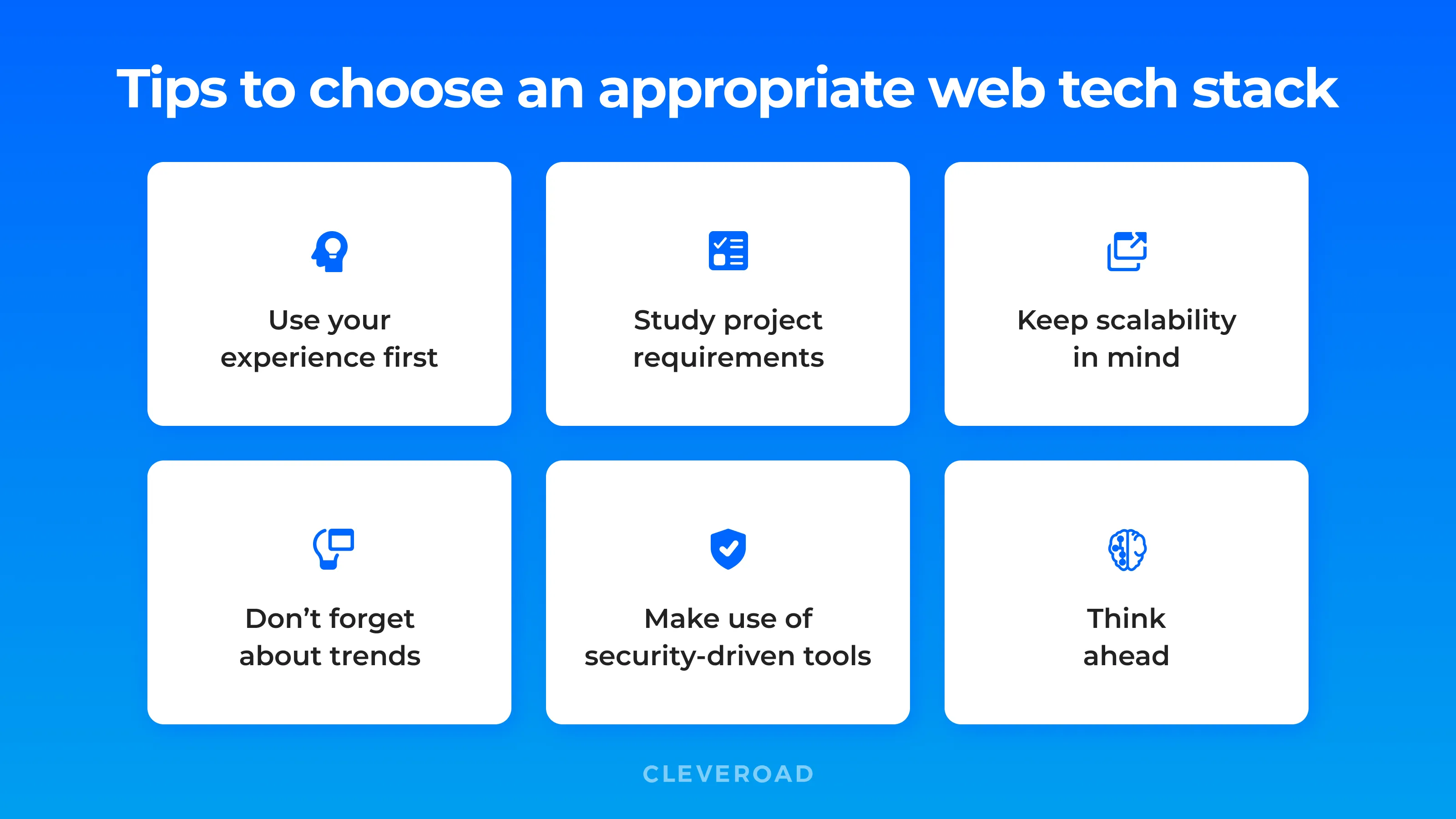
Tips to choose your web stack
Your experience should come first
That means you need to use the experience and skills you already have. For example, if your team includes Node.js developers and specialists experienced in other JavaScript technologies, use them to build a web application. Of course, it doesn’t mean you don’t need to learn something new, but it's always better to apply strong skills that you've already used many times. Besides that, if it is a typical web app, you probably already have a set of tools that may be integrated faster and let you build a website or web app with fewer efforts.
Define the requirements of your project
First, you need to determine your target audience and who you build a project for. Their age, their interests, it will help you think through UX of the project to meet all expectations of potential customers. Then, you need to define the complexity of the project - will it be a simple landing page or a complex eCommerce website? When you will answer these questions, you will be able to understand better what web application stack you’d better select in this specific case. Angular framework is a good choice for a single-page web app, whereas complex websites will require you and your team use .Net, JS frameworks and libraries along with databases and storages.
Keep up with scalability
The architecture of your web app should be as simple as possible, however, mind that you need to make it scalable. Perhaps, you will need to add something in the future or during the development process, and you shouldn’t ignore this fact. In addition, scalability means that your web app will be able to respond to load increase and an unexpected amount of possible users. You should choose horizontal or vertical scalability, depending on your requirements. To achieve scalability, it is recommended to use powerful programming languages like JavaScript that come along with libraries and frameworks that enhance the language and make it more flexible.
Find out the cost of building a website in 2019. Read How much does it cost to make a website
Comply with trends
As we noted above, it is recommended to use well-tried tools for web apps building, however, make sure that technologies you use will be as trendy in the future as they are nowadays. Because it is much easier and more reliable to use tools that are accepted by large developers’ communities, you can always find a solution on the web because there are many specialists that work with these technologies. That is why we recommend you to keep up with trendy technologies but don’t forget about the future.
Concentrate on solid security
Any customer wants the product to be secure and reliable to make sure that all users will apply it calmly, without any worries about the security of their data. Thus, you need to use technologies that are encrypted and protected to provide future users with a good service especially if you are planning financial software development and data processing. Mind to learn all security issues before you start using any technologies - you should be confident in a tool you plan to integrate.
Evaluate your skills clearly
If you choose a certain technology, be sure that you will be able to implement everything you need due to this technology and you won’t fail halfway through software development. You need to think ahead, then you won’t face any troubles related to challenges with skills you are not good at or budget issues. Simply put - don’t bite off more than you can chew.
Think about expediency
Don’t chase latest technology stack for web development if you and your team are good at old-school but still topical tech stacks. If you think that it is not expedient to use new tech stack only because it became popular month ago, but it doesn’t mean that it will remain the same one year later, you’d better use well-tried technologies and select a similar but time-tested tech stack. For example, our web development team always keep up with all novelties in the web development world, however, they keep on using MEAN stack along with .Net stack because they know the tools are included in these stacks will remain reliable and tested even a few years later.
These tips will help you choose your tech stack. However, it's a good idea to ask for advice in web application development company you're planning to work with (in case of outsourcing). Usually, every company has its own core tech stack.
Web Technology Stack of Popular Projects
Finally, let’s take a look at the tech stack that was used by famous companies.
YouTube
A video-sharing service that allows users to upload their videos, leave comments, share videos, make playlists, and so on. YouTube became the most popular platform for video blogging.
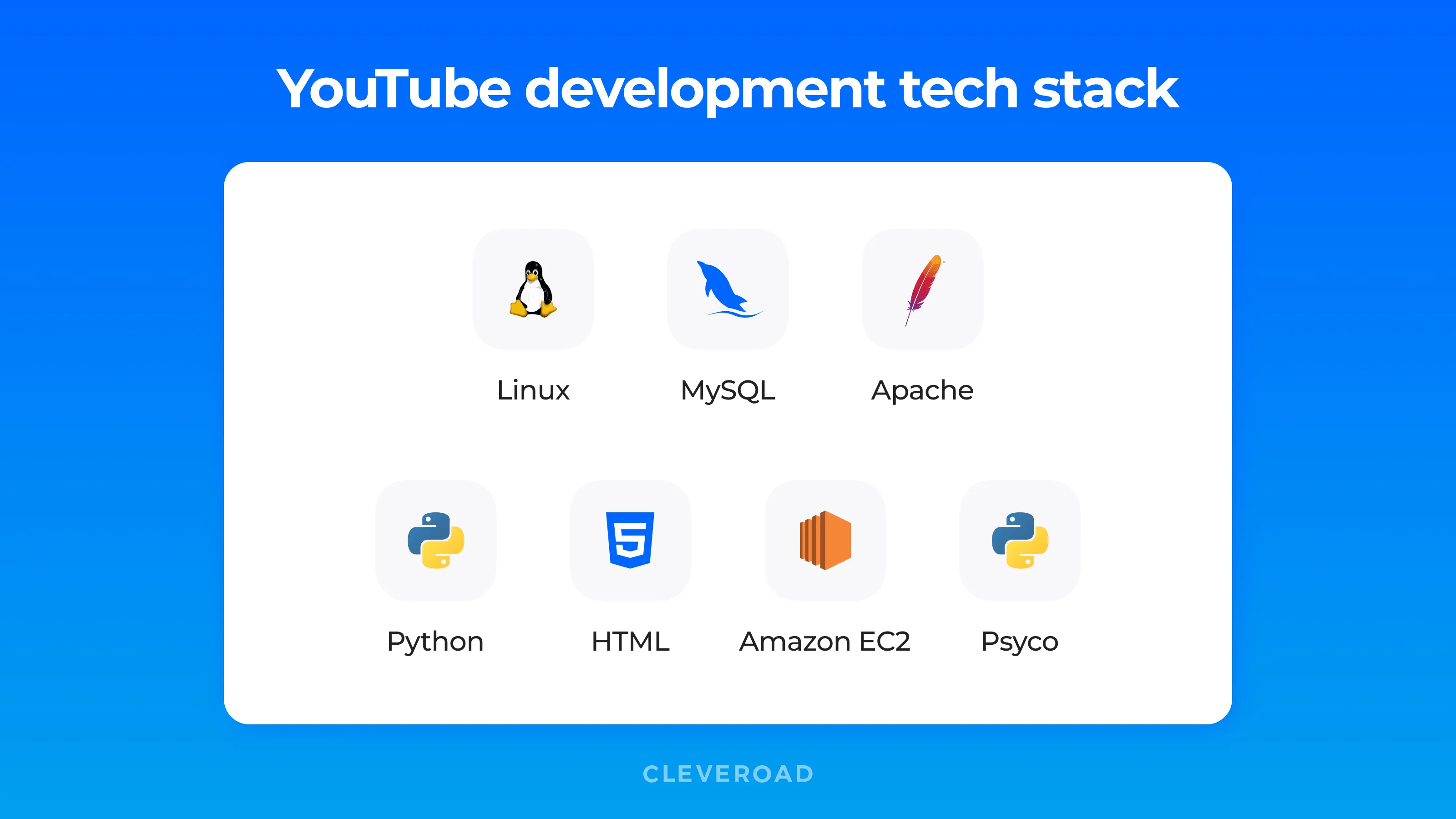
YouTube website tech stack
Uber
A transportation network company that offers taxi service in a way different from a conventional one. Uber connects usual drivers that may share a ride with passengers. By the way, as official Uber website says, 14 million trips completed each day. Consider also Uber app development cost if you plan to build one.
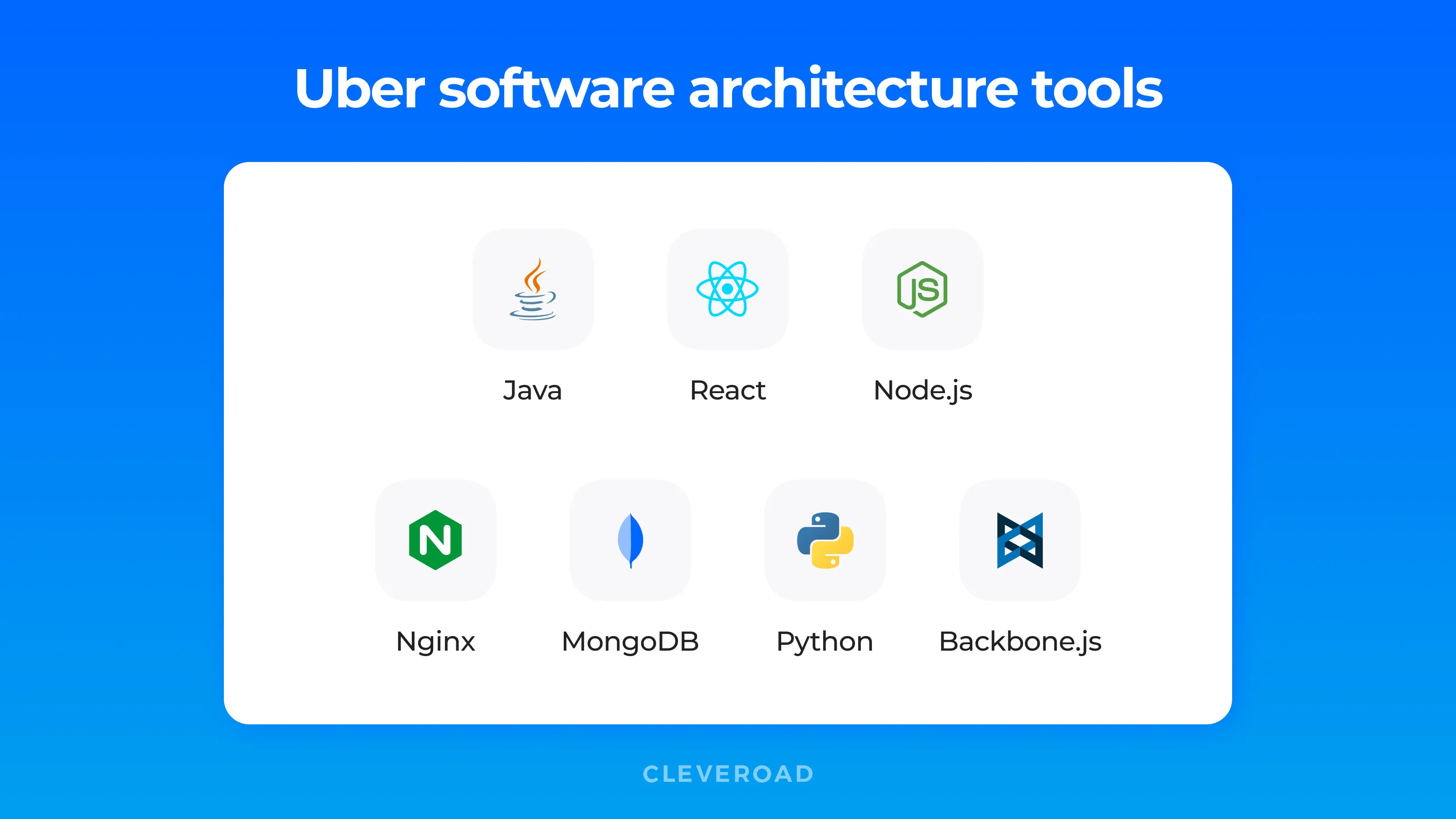
Uber website tech stack
Netflix
On-demand video streaming service that hosts a wide range of content - TV shows, TV series, movies, cartoons, and so on. It works on a paid subscription model. This detailed guide explains how to make a streaming service like Netflix.
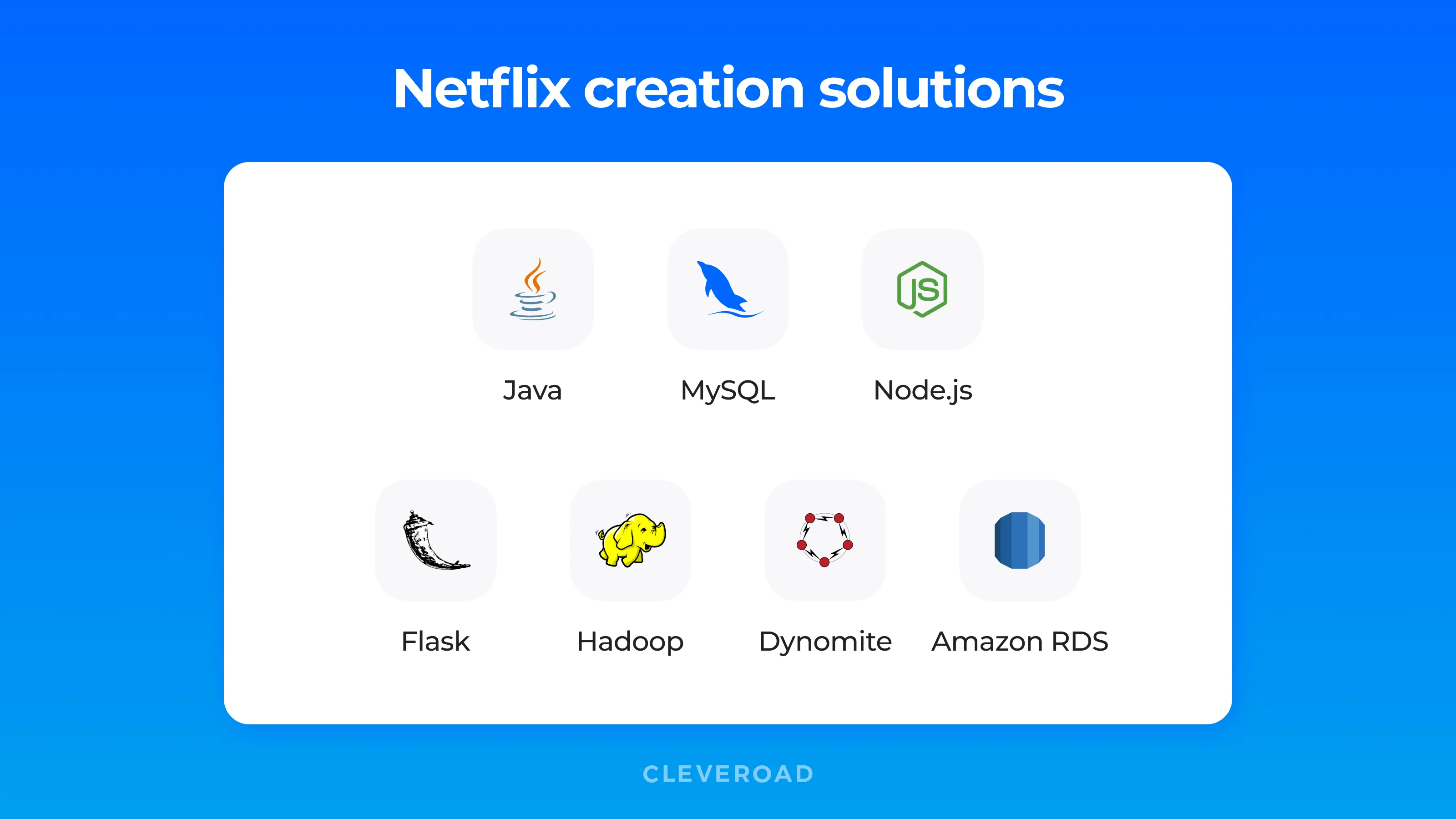
Tech stack of Netflix streaming service
Slack
A corporate messenger built for enterprises to let teams communicate with each other easily. It is a communication hub that has many useful features like organized conversations, searchable history, integration with third-party apps, etc.
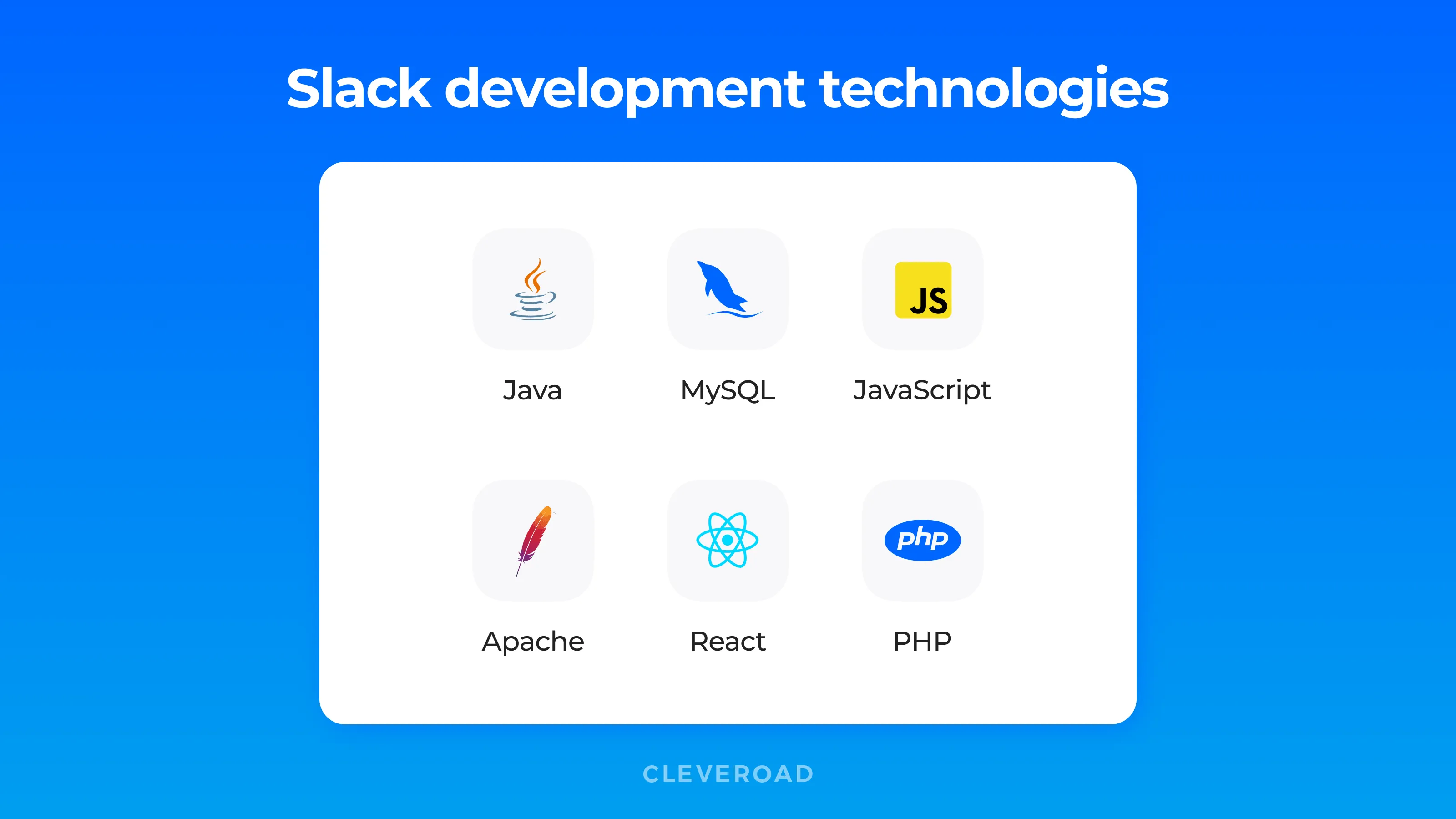
Tech stack of Slack corporate messenger
A photo and video-sharing social network that is connected to Facebook. Users can follow each other not to miss new pictures of their friends. As of 2018, Instagram is the second most engaged social network, according to eMarketer. By the way, Facebook is the first one. Anyway, you can still be interested in the development of Instagram app clone, check it out.
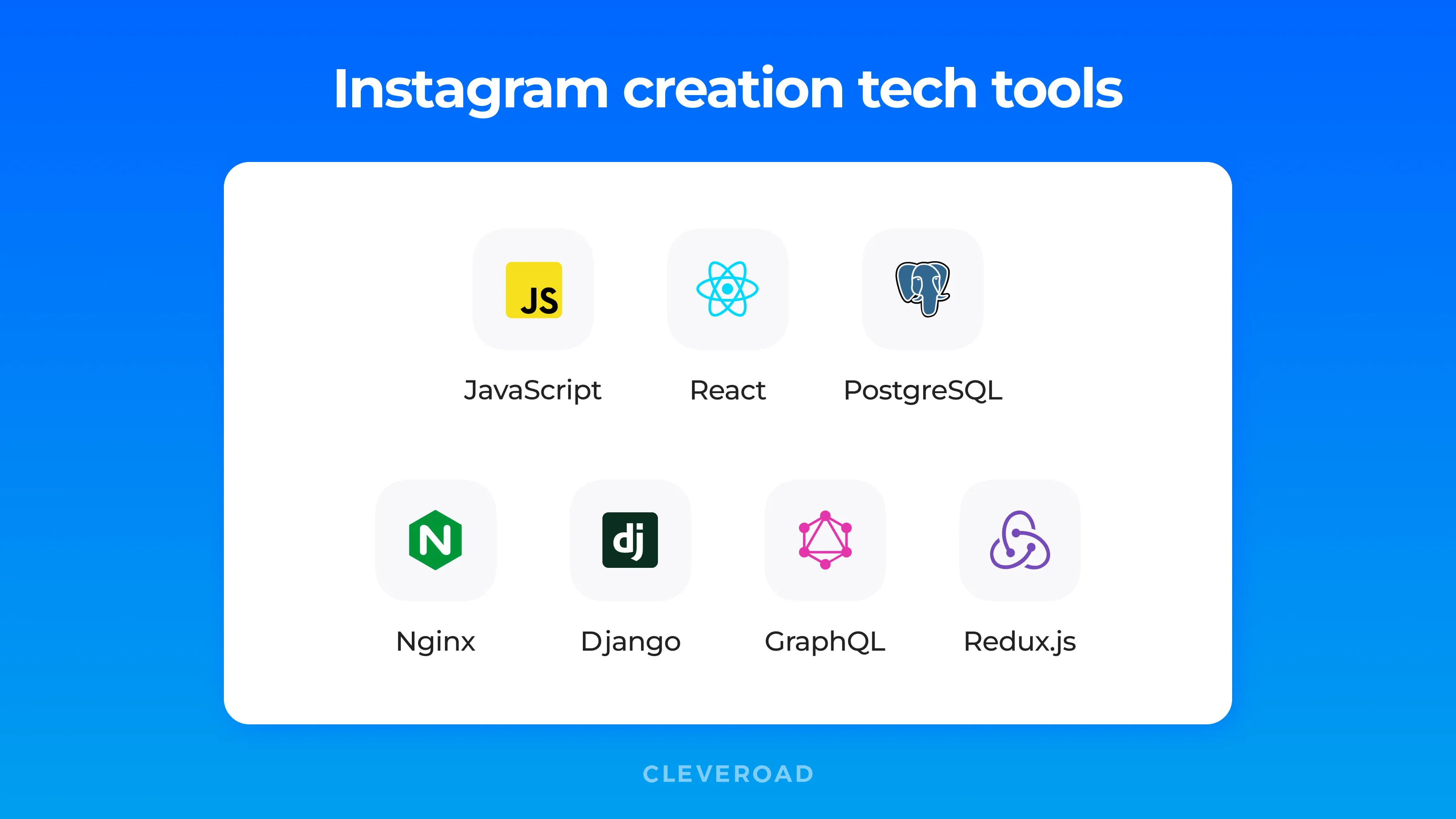
Instagram social network and its tech stack
Wrapping up, we would like to emphasize that choosing the best web technology stack for web application is a serious challenge that you should be prepared to. But if you will follow all tips and mind to use proven technologies, you will have more chances to succeed.
Cleveroad Expertise: Picking Web Stack and Flawless Projects Delivery
Cleveroad is your trustworthy web architecture partner from Estonia. We deliver a wide range of software architecture services. Website development from scratch is an integral part of our competence.
A team of qualified AWS-qualified professionals from Cleveroad will eagerly provide you with the following web building services:
Custom website creation tailored to the requirements of your specific case UI/UX web design building for an enhanced user experience Quality Assurance web testing ensures a flawless website operation Maintenance and support of your web solution, expanding its functionality and regularly updating it
What solutions our tech team commonly used to architect flawless web products for our clients:
- HTML
- JavaScript
- CSS
- Node.js
- Angular
- AWS
- GraphQL
- TypeScript
- MySQL
- React
- C#
You are welcome to get acquainted with our project cases proving our solid expertise in web development.
We’ve singled out seven tips you need to keep up with to make the right choice if you want to choose the best technology stack for web development.
- Tip 1. Your experience should come first
- Tip 2. Define the requirements of your project
- Tip 3. Keep up with scalability
- Tip 4. Follow the latest web development trends
- Tip 5. Pay attention to the security
- Tip 6. Think ahead
- Tip 7.Consider expediency
It is a combination of tools such as programming languages, frameworks and so one, that were used while building a mobile or web solution. In turn, these tools are divided into the frontend and backend.
The web development tools are divided into the frontend and backend. The core web technologies for frontend list includes:
- HTML
- CSS
- JavaScript
- SCSS
- SASS
- LESS
As for backend development, there are a bunch of tools:
- Operating system: Linux, Windows
- Web server: nginx, Apache
- Databases: MySQL, PostgreSQL, MongoDB, ElasticSearch, DynamoDB, Firebase Database, Indexed DB 2.0
- Storage: AWS S3, Firebase Storage
- Hosting: Firebase Hosting, AWS S3 Bucket in hosting mode, Amazon EC2 (Linux), nginx
- Programming language: JavaScript (Node.js), C# (.Net)
- Web development frameworks: Laravel, Yii2, Zend, Express, Nest.js
It usually stands for MongoDB (database), Express (backend framework), Angular and Node.js (backend platform). However, its technologies may vary, web developers may use MySQL database instead of MongoDB, everything depends on which kind of DB is better to use for a specific project - a document-oriented or relational one.
There are a few most popular web stacks that include tools for frontend and backend development.
- LAMP. Its abbreviation stands for Linux (OS), Apache (server), MySQL (database), PHP or Perl (backend language). This web application technology stack is an appropriate option if you need to build your app quickly since it allows you to deploy web app faster, it has flexibility during selections of the database.
- Python-Django tech stack. Python language together with the Django framework may be used for server-side development, and web developers often use Apache, MySQL or PostgreSQL to build web apps. Django is good for its security features (prevention of CSRF and SQL injections), its own ORM layer for handling database access, but it is slow, lacks convention, not appropriate for small websites.

Evgeniy Altynpara is a CTO and member of the Forbes Councils’ community of tech professionals. He is an expert in software development and technological entrepreneurship and has 10+years of experience in digital transformation consulting in Healthcare, FinTech, Supply Chain and Logistics
Give us your impressions about this article
Give us your impressions about this article